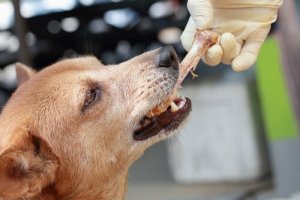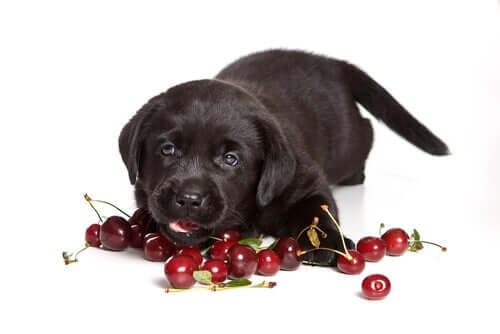Toxic Foods for Dogs: What Should I Avoid?


Written and verified by the biologist Ana Díaz Maqueda
Whether you feed your dog natural food or treats that aren’t really meant for dogs, it’s important to know which foods are toxic foods for dogs. Dogs can tolerate a wide range of different foods, but there are still some that are harmful to them.
In most cases, a small amount of these products won’t have any visible effect. But higher doses can lead to indigestion, and some compounds can lead to death if their stomach isn’t pumped quickly.
In this article, we’ll share some of the toxic foods for dogs so that you know what to avoid.
Tea, coffee, or chocolate
These three foods all contain a compound known as methylxanthine which excites the central nervous systems. Tea contains theophylline, coffee contains caffeine and chocolate contains theobromine.

In small quantities, these substances won’t do much harm, but a lethal dose is not very high. In fact, giving an ounce of pure dark chocolate to a small dog could cause irreversible damage.
Some symptoms of food poisoning include seizures, tremors, diarrhea, and incontinence.
Onion and garlic
Garlic (allium sativum) and onion (allium cepa) are part of the Amaryllidaceae family and both can cause hemolytic anemia. Unline nonhemolytic anemia (caused by an iron deficiency), this syndrome causes the destruction of red blood cells, lowering their concentration in the blood.
If a dog eats a little garlic or onion every now and again, it’s not going to be a problem. The problem comes when a dog eats these foods every day and in high quantities.
Avocado
Avocado contains a substance that is toxic to many animals called persin. Dogs and cats actually seem to be unaffected by this substance. The real danger is that your dog might swallow the stone and this could obstruct their digestive system.
There is also, however, the possibility that your dog may suffer from pancreatitis because of the high fat content in avocados.
Macadamia nuts
Macadamia nuts are one of the toxic foods for dogs and they can be life-threatening if food poisoning symptoms aren’t treated.
Poisoning normally occurs 24 hours after ingestion and directly affects the dog’s central nervous system. This can cause ataxia, depression, tremors, convulsions, vomiting, and abdominal pain.
Cherries
Cherries are the fruits borne by shrubs and trees of the genus Prunus. Something they all have in common is that they’re rich in cyanogenic glucosides. All parts of the plant, except for the flesh around the stone, are toxic since they contain a high concentration of cyanide.

Cyanide stops the body from being able to transport oxygen properly, leading to symptoms such as:
- Dilated pupils
- Difficulty breathing
- Not enough oxygen
- Bright red gums
- Shock and even death
Cooked bones
Raw bones are highly beneficial for dogs. As well as providing high-value nutrients, they also help prevent the appearance of tartar and can even eliminate it. They’re also fun entertainment as they spend hours chewing on them.
However, cooked bones will have lost their natural collagen. This makes them potentially dangerous as they can splinter and get stuck in the digestive tract, causing serious damage. It can even be fatal.
Other toxic foods for dogs
There are many other toxic foods for dogs which can be life-threatening. They include:
- Salt
- Alcohol
- Mushrooms
- Grapes or raisins
- Apricots
- Raw bread dough
- Hot spices
- Sugar
- Almonds
- Raw potatoes or sweet potatoes
- Moldy or rotten food
Whether you feed your dog natural food or treats that aren’t really meant for dogs, it’s important to know which foods are toxic foods for dogs. Dogs can tolerate a wide range of different foods, but there are still some that are harmful to them.
In most cases, a small amount of these products won’t have any visible effect. But higher doses can lead to indigestion, and some compounds can lead to death if their stomach isn’t pumped quickly.
In this article, we’ll share some of the toxic foods for dogs so that you know what to avoid.
Tea, coffee, or chocolate
These three foods all contain a compound known as methylxanthine which excites the central nervous systems. Tea contains theophylline, coffee contains caffeine and chocolate contains theobromine.

In small quantities, these substances won’t do much harm, but a lethal dose is not very high. In fact, giving an ounce of pure dark chocolate to a small dog could cause irreversible damage.
Some symptoms of food poisoning include seizures, tremors, diarrhea, and incontinence.
Onion and garlic
Garlic (allium sativum) and onion (allium cepa) are part of the Amaryllidaceae family and both can cause hemolytic anemia. Unline nonhemolytic anemia (caused by an iron deficiency), this syndrome causes the destruction of red blood cells, lowering their concentration in the blood.
If a dog eats a little garlic or onion every now and again, it’s not going to be a problem. The problem comes when a dog eats these foods every day and in high quantities.
Avocado
Avocado contains a substance that is toxic to many animals called persin. Dogs and cats actually seem to be unaffected by this substance. The real danger is that your dog might swallow the stone and this could obstruct their digestive system.
There is also, however, the possibility that your dog may suffer from pancreatitis because of the high fat content in avocados.
Macadamia nuts
Macadamia nuts are one of the toxic foods for dogs and they can be life-threatening if food poisoning symptoms aren’t treated.
Poisoning normally occurs 24 hours after ingestion and directly affects the dog’s central nervous system. This can cause ataxia, depression, tremors, convulsions, vomiting, and abdominal pain.
Cherries
Cherries are the fruits borne by shrubs and trees of the genus Prunus. Something they all have in common is that they’re rich in cyanogenic glucosides. All parts of the plant, except for the flesh around the stone, are toxic since they contain a high concentration of cyanide.

Cyanide stops the body from being able to transport oxygen properly, leading to symptoms such as:
- Dilated pupils
- Difficulty breathing
- Not enough oxygen
- Bright red gums
- Shock and even death
Cooked bones
Raw bones are highly beneficial for dogs. As well as providing high-value nutrients, they also help prevent the appearance of tartar and can even eliminate it. They’re also fun entertainment as they spend hours chewing on them.
However, cooked bones will have lost their natural collagen. This makes them potentially dangerous as they can splinter and get stuck in the digestive tract, causing serious damage. It can even be fatal.
Other toxic foods for dogs
There are many other toxic foods for dogs which can be life-threatening. They include:
- Salt
- Alcohol
- Mushrooms
- Grapes or raisins
- Apricots
- Raw bread dough
- Hot spices
- Sugar
- Almonds
- Raw potatoes or sweet potatoes
- Moldy or rotten food
All cited sources were thoroughly reviewed by our team to ensure their quality, reliability, currency, and validity. The bibliography of this article was considered reliable and of academic or scientific accuracy.
- Alcohol. 2019, de Pet Poison HelpLine Sitio web: https://www.petpoisonhelpline.com/poison/alcohol/
- Al-Khalidi, U. A. S., & Chaglassian, T. H. (1965). The species distribution of xanthine oxidase. Biochemical Journal, 97(1), 318-320.Avocado. 2019, de Pet Poison HelpLine Sitio web: https://www.petpoisonhelpline.com/poison/avocado/
- Cherry. 2019, de Pet Poison HelpLine Sitio web: https://www.petpoisonhelpline.com/poison/cherry/
- Briggs, W. H., Folts, J. D., Osman, H. E., & Goldman, I. L. (2001). Administration of raw onion inhibits platelet-mediated thrombosis in dogs. The Journal of nutrition, 131(10), 2619-2622.
- Eubig, P. A., Brady, M. S., Gwaltney‐Brant, S. M., Khan, S. A., Mazzaferro, E. M., & Morrow, C. M. (2005). Acute renal failure in dogs after the ingestion of grapes or raisins: a retrospective evaluation of 43 dogs (1992–2002). Journal of veterinary internal medicine, 19(5), 663-674.
- Hansen, S. R., Buck, W. B., Meerdink, G., & Khan, S. A. (2000). Weakness, tremors, and depression associated with macadamia nuts in dogs. Veterinary and human toxicology, 42(1), 18-21.
- Lee, K. W., Yamato, O., Tajima, M., Kuraoka, M., Omae, S., & Maede, Y. (2000). Hematologic changes associated with the appearance of eccentrocytes after intragastric administration of garlic extract to dogs. American journal of veterinary research, 61(11), 1446-1450.
- Mushrooms. 2019, de Pet Poison HelpLine Sitio web: https://www.petpoisonhelpline.com/poison/mushrooms/
- Salt. 2019, de Pet Poison HelpLine Sitio web: https://www.petpoisonhelpline.com/poison/salt/
- Spice, R. N. (1976). Hemolytic anemia associated with ingestion of onions in a dog. The Canadian Veterinary Journal, 17(7), 181.
This text is provided for informational purposes only and does not replace consultation with a professional. If in doubt, consult your specialist.








